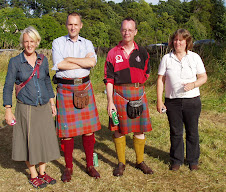We’ll start with knitting today.
I’ve reached the point, towards the top of the second rank of Green Granite Blocks, where I stop knitting the fronts of the blocks and start knitting the tops as they recede into 3-D space. That means a slow row, which I have nearly worked my way across – changing colours for each of the five blocks, and also adding black and nearly-black sections to represent Space. Once this row is set, I shall speed forward to the end of the blocks, and take another picture.
The current system is working well – butterflies for the fronts of the blocks, 15 stitches at a time; long pull-through-the-tangle strands for the other colour sections. I had a struggle with the winding of butterflies, due, I now think, to the fact that one of the videos which come up when one Googles the subject, is wrong.
You’re winding a small centre-pull ball. That must mean that the end of yarn you start with winds up being the end of yarn you knit with. The other end is used at the end to wind around the centre of the butterfly and secure it. Now that I’ve grasped that, things are going even better.
Another topic: there was an article in the Scotsman yesterday about something called the Moray Firth Gansey Project. It hunts for old patterns and also encourages local businesses “to use local gansey patterns in new ways, including glass.” They are about to stage their first exhibition, called “Extravagansey”, fortunately far from here.
This would be harmless enough except that they have received grants of ninety thousand pounds to carry them forward. The usual suspects: the Lottery Fund, the Scottish Government, the EU, and a couple of local sources.
And what will they achieve that Gladys Thompson didn’t manage half a century ago – when there were still fishermen about who wore the things? I am sure she never saw ninety thousand pounds in her life. Nor Sharon Miller for her work on Shetland lace, still, precariously, a living tradition. We could all, easily, list a dozen other names of scholars who have done distinguished work on the Scottish knitting traditions, for little or no reward.
A few interesting ganseys may emerge from drawers, for that much money. Nothing wrong with that.
But Extravagansey! Forsooth!
Vegetables
Salsola soda has been sown in the dining room. Results breathlessly awaited.
Thanks for yesterday’s comments. Hat, thank you for the encouraging news that bunching onions may turn out as I anticipate, and for the offer of some garlic chives. Anonymous, if bunching onions deliver the goods, I won’t need to sow more seed, but I will bear your auggestion in mind – sowing in the autumn and over-wintering the little onions.
The opium poppy, papaver somniferum, turns up in my garden as a weed, as it uncannily does wherever there is empty, cultivated ground. I love the flowers, and always leave a few. Last year they were scarce, and I worried. One of you comforted me by saying that there are years, and there are other years. Well, you were right. They are back in super-abundance. I have been pulling them out by the fistful (although of course leaving some). It's Kandahar-sur-Ardle, this time.
Thursday, June 10, 2010
Subscribe to:
Post Comments (Atom)




We've got some opium poppy to move over from next door into our front slope, which we're trying to turn into a meadowy orchard, since I refuse to mow it after injuring my leg doing so a couple of summers ago because of the steep grade. Just so long as federal agents don't come snooping around.
ReplyDeleteI bet Mary Wright didn't get financial assistance on that scale when she was researching her "Cornish Knitfrocks and Guernseys".
ReplyDeletePoppies of all sorts are abundant hereabouts in the East Midlands - maybe the cold winter encouraged plenty of the seeds out of dormancy.
My opium poppies are not very abundant this year. I guess my dreams of a little side business will have to wait...
ReplyDeleteHow very true about the historic researches of Mrs. Thompson, Mrs. Miller and Mrs. Wright (among others). They did it for the love of knitting traditions, not a huge prize money. One can hope the "Extravagansey" doesn't turn out too hideous. -- Joe-in Wyoming
ReplyDeleteStill, Thompson, Miller, Wright, et al didn't get all the patterns. Every so often another one is mentioned somewhere. Perhaps this project will startle a few more from hiding. I just hope the still-living researchers can get in on it somehow, perhaps to continue their research.
ReplyDeleteI am sure that, for £90,000 I could do a great deal of very valuable research. I find it strange that essential research like that done by those you mention, is usually done by penniless enthusiasts and then taken over by others for their own advantage.
ReplyDelete